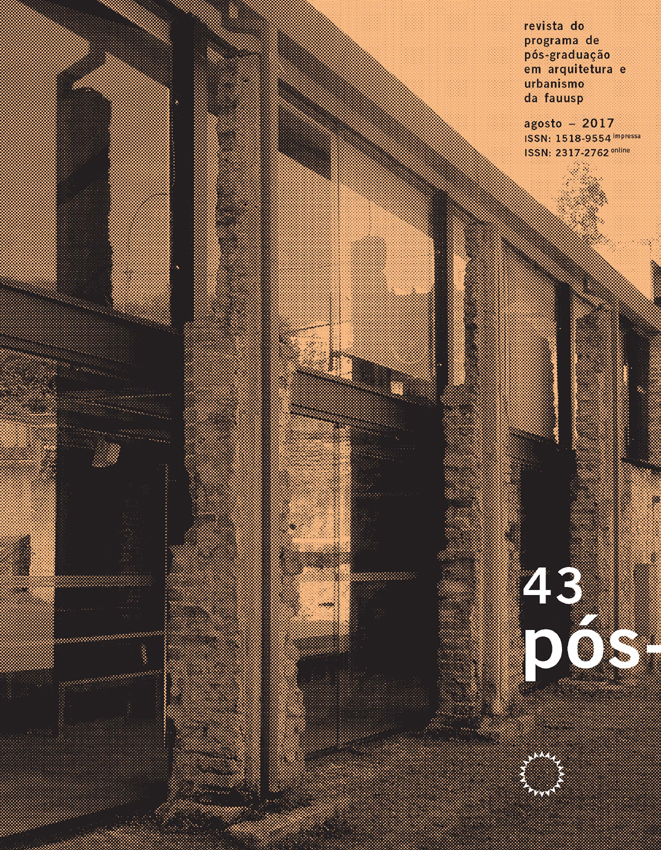Perception model SENS|ORG|INT in architecture: a case study on the colors used in Ceta Ecotel Macapá, Brazil
DOI:
https://doi.org/10.11606/issn.2317-2762.v24i43p98-111Keywords:
Color. Architecture. Perception.Abstract
The aim of this article is to present a study on how the use of colors on the internal and external architectural environments of a Brazilian hotel affected consumer behavior. The results are analyzed in terms of SENS|ORG|INT Model, which differentiates physiological aspects of color human response from cultural and interpretive aspects (CSILLAG, 2008). The study was conducted at Ceta Ecotel, an ecological hotel at the city of Macapá on the northeastern coast of Brazil. The methodology was of a case study (YIN, 2004), using a triangulation process, crossing information obtained from three points of view: a qualitative & quantitative questionnaire with 50 employees of the hotel, including the owners, a qualitative & quantitative questionnaire with 640 guests of the hotel, and analyses of the data obtained using SENS|ORG|INT Model of Perception. Results show consumers’ most and least preferred colors for the environment. Results indicated reasons for the most and least preferred colors, presenting suggestions for future use of colors in architectural projects.
Downloads
References
ALI, Mark. Pattern of EEG Recovery Under Photic Stimulation by Light of Different Colors.” Electoencephalography Clinical Neuropshysiology 22: 332-35. 1972.
BERKELEY, George. Berkeley Selections. New York: Scribner’s, 1929.
BLIKSTEIN, Izidoro. Kaspar Hauser Ou A Fabricação Da Realidade. São Paulo: Cultrix / Edusp, 1983.
BRUCE, Vicki; GREEN, Patrick; GEORGESON, Mark. Visual perception. Hove: Psychology Press, 2003.
BRUNER, Jerome. On Perceptual Readiness. In Psychol. Rev., Vol. 64, No. 2, 1957.
CAIVANO, Jose. Luis Research on Color in Architecture and Environmental Design: Brief History, Current Developments,and Possible Future. Color Research and Application. Vol.31, no. 4, 2006.
CHALUPA, Leo; WERNER, John. (Eds.). The visual neurosciences. Cambridge: MIT Press, 2004.
CSILLAG, Paula. A Model of Visual Perception Useful for Designers and Artists. In: Griffin, R.; D'averignou, M. (Org.). Visual Literacy Beyond Frontiers: Information, Culture and Diversity. Loretto: St. Francis University Press, v., p. 11-20, 2008.
CSILLAG, Paula. A Model of Visual Perception Useful for Designers and Artists. Journal of Visual Literacy, v. 28, p. 127-146, 2009.
CSILLAG, Paula. Comunicação Com Cores. São Paulo: SENAI SP, 2015.
CSILLAG, Paula. Food package chromatic design: A case study applying model Sens-Org-Int. Journal of the International Colour Association, v. 10, p. 37, 2013.
CSILLAG, Paula. Um mapeamento de estudos de cores frente ao Modelo SENS|ORG|INT de percepção visual de modo a identificar princípios cromáticos que tendem a ser generalizáveis aos seres humanos. Infodesign (SBDI. Online), v. 8, p. 39-47, 2011.
CSILLAG, Paula. Relationships between Neuroscience and visual perception model Sens-Org- Int contributing to Design practices,. In: Farias, Priscila Lena; Calvera, Anna; Braga, Marcos da Costa & Schincariol, Zuleica (Eds.). Design frontiers: territories, concepts, technologies CDHS 2012 - 8th Conference of the International Committee for Design History & Design Studies]. São Paulo: Blucher, p. 331-335 São Paulo: Blucher, 2014.
ISSN 2318-6968, ISBN: 978-85-212-0692-7
DOI 10.5151/design-icdhs-073
FRIELING, Heinrich. Gesetz der Farbe. Gottingen: Muster-Schmidt Verlag, 1990.
GERARD, Robert. The Differential Effects of Lights on Physiological Functions. Ph.D. Diss., University of California, Los Angeles, 1975.
GERBERT, Frank. Pshychologische und Physiologische Wirkungen von Umgebungsfarben. Philips-Universitat, Marburg, 1977.
GIBSON, James. The Ecological Approach To Visual Perception. Boston: Houghton-Mifflin, 1979.
HELMOLTZ, Hermann. Treatise on physiological optics: The perceptions of vision. Optical society of America, Ithaca, 1925.
HERING, Ewald. An Outline of a Theory of the Light Sense. Cambridge: Harvard University Press, 1964 (1878).
HUBEL, David; WIESEL, Torsten. Receptive Fields, Binocular Interaction And Functional Interaction and Functional Architecture Of The Cat’s Visual Cortex. In J. Physiol. Vol. 106, 1962.
HUBEL, David; WIESEL, Torsten. Receptive Fields Of Cells In Striate Cortex Of Very Young, Visually Inexperienced Kittens. In J. Neurophysiol., Vol. 26, 1963.
ITTEN, Johannes. The Art Of Color. New York: John Wiley & Sons, 1979.
KAISER, Peter; BOYNTON, Robert. Human color vision. Washington DC: Optical Society of America, 1996.
KAPLAN, Albert. Visual After-Images In Cases Of Disturbance Of The Normal Activity Of The Central Nervous System. Moscow: Acad. C&L, 1949.
KNOBLAUCH, Kevin; SHEVELL, Stuart. Color appearance. In Chalupa, L. & Werner, J. (Eds.). The visual neurosciences. Cambridge: MIT Press, 2004.
KÜLLER, Rikard; MIKELLIDES, Byron. and JANSSENS, Jan. Color, arousal, and performance—A comparison of three experiments. Color Research and Application, 34: 141–152, 2009.
KWALLEK, Nancy; SOON, Kokyung; LEWIS, Carol. Work Week Productivity, Visual Complexity, and Individual Environmental Sensitivity in Three Offices of Different Color Interiors. Color Research and Application. Vol.32, no. 2, 2007.
LEONTIEV, Aleksei. Problems In Mental Development. Moscow: Izd. Akad., 1959.
LURIA, Alexander Romanovich. Fundamentos De Neuropsicologia. Rio De Janeiro: Ed. Da Universidade De São Paulo, 1981.
MAHNKE, Frank. Color, Environment & Human Response. New York: John Wiley & Sons, 1996.
PINNA, Baingio; SPILLMAN, Lothar. Surface Color From Boundaries: a new watercolor illusion. Vision Research, 41, 2669-2676, 2001.
SACKS, Oliver. Um Antropólogo Em Marte. São Paulo: Cia. Das Letras, 2003.
SCHINDLER, Verena. Colour as vocation: Werner Spillmann's contribution to environmental colour design. Color Research and Application, 30: 53–65, 2005.
SHIMOJO Shinsuke; KAMITANI Yukiyasu; NISHIDA Shin'ya. Afterimage of perceptually filled-in surface. Science. Aug 31;293(5535):1677-1680, 2001.
SPILLMANN, Lothar; LEVINE, Joel. Contrast enhancement in a Hermann grid with variable figure-ground ratio. Experimental Brain Research, 13: 547-559, 1971.
TELFORD, Charles. Psicologia. São Paulo: Cultrix, 1970.
VYGOTSKY, Lev. Selected Psychological Investigations. Moscow: Izd. Akad, 1956.
VYGOTSKY, Lev. Development Of The Higher Mental Functions. Moscow: Izd. Akad.,1960.
YARBUS, Al'fred Luk'yanovich. Eye Movements And Vision. New York: Plenum Press, 1965.
YIN, Robert . Estudo de Caso. Planejamento e Métodos. 3ª ed. Porto Alegre: Bookman, 2004.
ZAPOROZHETS, Alexander. Perception And Action. Moscow: Prosv. Press, 1967.
ZAPOROZHETS, Alexander. Formation Of Perception In The Preschool Child. Moscow: Prosv. Press, 1968.
ZEKI, Semir. The architecture of the colour centre in the human visual brain: New results and a review. European Journal Of Neuroscience 12 (1), 172-193m 2000.
ZIMKINA, Anna Mikhaĭlovna. Some Special Features Of Tactile Trace Processes (After Images) In Man. Moscow: Izd. Acad,, 1957.
Downloads
Published
Issue
Section
License

This work is licensed under a Creative Commons Attribution 4.0 International License.
DIADORIM - Diretório de Políticas Editoriais












